Integrating Technological Environmental Design and Energy Interventions in the Residential Building Stock: The Pilot Case of the Small Island Procida
Abstract
:1. Introduction
2. Materials and Methods
2.1. Analytical Phase
2.2. Applicative Phase
2.3. Evaluative Phase
3. Results and Discussion
3.1. Application of the Research Method to the Pilot Case of Procida Island
- The lack of modification of openings: existing openings cannot be enlarged or reduced in size;
- Material restrictions: frame materials are restricted to wood only, and aluminum and PVC are not permitted;
- Paint requirements: wood frames must be paintable and painted in colors specified by the Color Plan (Piano Colori);
- Glass specifications: any thickness of smooth glass or crystal can be used.
- Historic center: the chosen solution is double glazing with low-emissivity coating and an argon-filled cavity (90% filled);
- Marina di Sancio Cattolico: the selected option is triple glazing, also with low-emissivity coating and argon-filled cavities (90% filled).
3.2. Discussion of the Results
- Scenario #1: wall and roof insulation;
- Scenario #2: wall and roof insulation + window replacement;
- Scenario #3: wall and roof insulation + window replacement + system replacement;
- Scenario #4: wall and roof insulation + window replacement + system replacement + photovoltaic system installation.
- This research introduces an innovative approach through the use of aggregated data and archetypal analysis for large-scale territorial evaluations, improving precision and scalability in energy efficiency interventions;
- A custom software system was developed to consolidate and analyze data from 2961 residential buildings on Procida, providing insights into the island’s diverse architectural and environmental contexts;
- An aggregated data analysis identified patterns and correlations that individual assessments may have overlooked, offering a macro-level perspective crucial for scalable, urban-wide solutions;
- The archetypal analysis groups buildings into representative types based on their structural and environmental features, enabling tailored and targeted energy intervention strategies;
- These approaches establish a strong framework for optimizing energy consumption and fostering energy self-sufficiency on a larger scale, particularly in residential settings;
- The proposed solutions are context-specific and scalable, contributing to broader environmental sustainability goals.
4. Conclusions
- A significant performance improvement is observed with the replacement of building systems;
- The annual reduction in local emissions, which is closely linked to primary energy demand reduction, is slightly higher for the first two interventions;
- The largest improvements come from installing photovoltaic systems and integrating renewable energies;
- Combined interventions lead to a 67% reduction in local emissions, promoting environmental sustainability;
- Primary interventions include thermal insulation and system replacement;
- Secondary interventions involve photovoltaic systems and energy storage;
- A holistic approach to building redevelopment, integrating technological and environmental solutions, is crucial for energy efficiency.
- The future research directions proposed are as follows:
- Advancements in renewable energy integration could impact costs, returns on investments, and savings;
- Innovations in building materials and energy systems may lower initial costs, with economies of scale and better financial models optimizing returns on investments;
- Future studies should quantify savings from advanced retrofitting techniques and emerging technologies, like smart grids;
- Environmental impact studies should further assess reductions in energy demand and emissions;
- The longitudinal monitoring of energy performance will help to assess long-term intervention effectiveness and sustainability;
- Research should also explore the economic and social impacts on property values, local economies, and quality of life;
- The integration of advanced building materials and smart energy systems should be further explored;
- Aligning energy efficiency initiatives with urban planning strategies could lead to comprehensive sustainability outcomes.
Author Contributions
Funding
Institutional Review Board Statement
Informed Consent Statement
Data Availability Statement
Acknowledgments
Conflicts of Interest
Appendix A
| User-Related Information | |
|---|---|
| number of occupants in the house: | number of occupants in the house in the morning (8 a.m.–1 p.m.); |
| number of occupants in the house in the afternoon (1 p.m.–7 p.m.); | |
| number of occupants in the house in the evening (7 p.m.–midnght); | |
| number of occupants in the house at night (midnight–8 a.m.). | |
| Architectural–morphological characteristics of the house | |
| year of construction of the building; | |
| number of floors in the building in which the dwelling is located; | |
| average height of floors; | |
| number of rooms (including hallways and corridors); | |
| number of windows; | |
| prevailing color of vertical external walls; | |
| prevailing color of the upper closure (roof or terraced surface); | |
| approximate morphological plan typology of the dwelling; | |
| exposure with respect to the cardinal points (locating north); | |
| sides bordering the outside; | |
| sides bordering other flats or other buildings; | |
| possible presence of other flats above or below; | |
| total surface area of the dwelling; | |
| net area (without perimeter walls) of the dwelling; | |
| presence or absence of thermal insulation of horizontal and vertical opaque closures; | if present, percentage of thermal insulation; |
| characteristics of windows (whether original or replaced); | in case of replacement, number of windows replaced. |
| Characteristics of the plant system | |
| type of winter air-conditioning system (autonomous or centralised): | type of heat generator; |
| type of heat distribution terminal; | |
| regulation system for the winter air-conditioning system (manual thermostat, programmable thermostat, thermostat value on each terminal); | |
| energy class of the dwelling; | |
| presence of summer air-conditioning system: | if present, in which and how many rooms; |
| energy class of summer air-conditioning terminals; | |
| presence of other summer air-conditioning appliances; | |
| type of plant for DHW production; | |
| presence of solar thermal system (for DHW production): | if any, how many panels, orientation, slope and tilt angles; |
| Presence of PV system (for electricity production): | if any, how many panels, orientation, slope and tilt angles; |
| if present, specify the power, the capacity of the system, and whether there is a storage tank; | |
| Characteristics of the appliances in the house | |
| appliances in the kitchen: | hours of daily use of each appliance; |
| type of fridge and volume in litres: | energy class of the appliance; |
| washing clothes (washing machine and/or tumble dryer): | load capacity and number of washes per week performed; |
| energy class of the appliance; | |
| presence of other appliances: | total daily usage in minutes; |
| type of lighting system; | |
| presence and number of TVs: | size of each TV; |
| energy class of the TV; | |
| total daily hours of use; | |
| other electrical devices: | total daily hours of use; |
| presence and number of PCs: | total daily hours of use; |
| type of Internet connection for surfing the Internet; | |
| presence and type of printer: | average number of prints per day; |
| type of personal care appliances: | total daily usage minutes; |
| Energy consumption and costs | |
| usual or seasonal residence; | |
| electricity: | type of contract (free or captive market); |
| actual consumption for various months in kW/h; | |
| actual expenses of the various months in euros; | |
| gas: | type of contract (free or captive market); |
| actual consumption for various months in Sm3; | |
| actual expenses of the various months in EUR; | |
References
- World Economic Forum. The Global Risks Report 2024—19th Edition—Insight Report. Cologne. 2024. Available online: https://www3.weforum.org/docs/WEF_The_Global_Risks_Report_2024.pdf (accessed on 3 August 2024).
- United Nations Environment Programme. Emissions Gap Report 2022: The Closing Window—Climate Crisis Calls for Rapid Transformation of Societies. Nairobi. 2022. Available online: https://www.unep.org/emissions-gap-report-2022 (accessed on 3 August 2024).
- World Green Building Council. Global Policy Principles for a Sustainable Built Environment. London. 2023. Available online: https://worldgbc.org/wp-content/uploads/2023/04/WorldGBC-Global-Policy-Principles_FINAL.pdf (accessed on 3 August 2024).
- World Economic Forum. The Building Sector Is Key to the Fight Against Climate Change; World Economic Forum: Cologny, Switzerland, 2024. [Google Scholar]
- Ashrafuzzaman, M.; Furini, G.L. Climate change and human health linkages in the context of globalization: An overview from global to southwestern coastal region of Bangladesh. Environ. Int. 2019, 127, 402–411. [Google Scholar] [CrossRef] [PubMed]
- Zhang, Y.; Wang, C.H.; Davies, H.A. Net-zero energy buildings: The integration of renewable energy sources and efficient design strategies. Renew. Energy 2021, 164, 1131–1145. [Google Scholar]
- Albadry, S.; Tarabieh, K.; Sewilam, H. Achieving Net Zero-Energy Buildings through Retrofitting Existing Residential Buildings Using PV Panels. Energy Procedia 2017, 115, 195–204. [Google Scholar] [CrossRef]
- World Green Building Council. Beyond Buildings. Why An Integrated Approach to Buildings and Infrastructure Is Essential for Climate Action and Sustainable Development. London. 2021. Available online: https://worldgbc.s3.eu-west-2.amazonaws.com/wp-content/uploads/2022/08/10190455/Beyond-Buildings_reduced_compressed.pdf (accessed on 3 August 2024).
- Romano, G.; Mancini, F. Transformation of a historical building into a Nearly Zero Energy Building (nZEB). J. Phys. Conf. Ser. 2022, 2385, 012008. [Google Scholar] [CrossRef]
- United Nations Environment Programme. Global Status Report for Buildings and Construction: Beyond Foundations: Mainstreaming Sustainable Solutions to Cut Emissions from the Buildings Sector. Nairobi. 2024. Available online: https://www.unep.org/resources/report/global-status-report-buildings-and-construction (accessed on 3 August 2024).
- Zhang, R.; Yin, L.; Jia, J.; Yin, Y. Application of ATS-GWIFBM Operator Based on Improved Time Entropy in Green Building Projects. Adv. Civ. Eng. 2019, 2019, 3519195. [Google Scholar] [CrossRef]
- REN21. Renewables 2024 Global Status Report. 2024. Available online: https://www.lerenovaveis.org/contents/lerpublication/2024_abr_ren21_renewables-2024--global-status-report.pdf (accessed on 3 August 2024).
- EC; Communication from the Commission to the European Parliament; the European Council; the Council; the European Economic and Social Committee; the Committee of the Regions. The European Green Deal. COM(2019) 640 Final, Bruxelles. 2019. Available online: https://eur-lex.europa.eu/resource.html?uri=cellar:b828d165-1c22-11ea-8c1f-01aa75ed71a1.0006.02/DOC_1&format=PDF (accessed on 3 August 2024).
- Haas, R.; Rainer, K.R.; Kecskés, H.R.B. Achieving 2030 targets: The role of national energy and climate plans in EU member states. Energy Rep. 2022, 8, 109–124. [Google Scholar]
- MiSE; MATTM; MIT. Piano Nazionale Integrato per l’Energia e il Clima, Roma. 2020. Available online: https://www.mimit.gov.it/images/stories/documenti/PNIEC_finale_17012020.pdf (accessed on 3 August 2024).
- Baroni, G.; Manzolini, M.; Gattari, V. Piano Nazionale Integrato per l’Energia e il Clima: Analisi delle misure per la sostenibilità energetica e ambientale in Italia. Riv. Ital. Energ. 2020, 37, 112–129. [Google Scholar]
- Civita, M.; Giacobazzi, L.D.; Bolognini, T. Le Politiche Energetiche Italiane Verso il 2030: Un’analisi del PNIEC e dei Suoi Impatti. 2022. Available online: https://www.fondazionesvilupposostenibile.org/wp-content/uploads/dlm_uploads/PNIEC-analisi-preliminare-Stakeholder-Forum-I4C-20-luglio.pdf (accessed on 3 August 2024).
- Camera dei Deputati Servizio Studi XVIII Legislatura. Il Piano Nazionale di Ripresa e Resilienza (PNRR), Roma. 2022. Available online: https://www.governo.it/sites/governo.it/files/PNRR.pdf (accessed on 3 August 2024).
- Sartori, I.; Sechi, P.L.; Castaldi, G. Il Piano Nazionale Integrato per l’Energia e il Clima: Obiettivi e Misure per il 2030 in Italia. 2021. Available online: https://www.efficienzaenergetica.enea.it/glossario-efficienza-energetica/lettera-p/piano-nazionale-integrato-per-l-energia-e-il-clima-2030-pniec.html (accessed on 3 August 2024).
- López, A.; Pardo, F. National Integrated Energy and Climate Plans: An analysis of European Union member states’ strategies. Renew. Sustain. Energy Rev. 2020, 127, 109847. [Google Scholar]
- Moschetti, R.; Brattebø, H. Sustainable Business Models for Deep Energy Retrofitting of Buildings: State-of-the-art and Methodological Approach. Energy Procedia 2016, 96, 435–445. [Google Scholar] [CrossRef]
- Ge, J.; Wang, Y.; Zhou, D.; Gu, Z.; Meng, X. Effects of urban vegetation on microclimate and building energy demand in winter—An evaluation using coupled simulations. Sustain. Cities Soc. 2024, 102, 105199. [Google Scholar] [CrossRef]
- OJEU. Directive (EU) 2018/844 of the European Parliament and of the Council of 30 May 2018 Amending Directive 2010/31/EU on the Energy Performance of Buildings and Directive 2012/27/EU on Energy Efficiency—L 156/75 of 19.6.2018. 2018. Available online: https://eur-lex.europa.eu/legal-content/EN/TXT/PDF/?uri=CELEX:32018L0844 (accessed on 3 August 2024).
- OJEU. Directive (EU) 2018/2002 of the European Parliament and of the Council of 11 December 2018 Amending Directive 2012/27/EU on Energy Efficiency—L 328/210 of 21.12.2018. 2018. Available online: https://eur-lex.europa.eu/legal-content/EN/TXT/PDF/?uri=CELEX:32018L2002 (accessed on 3 August 2024).
- IEA. Net Zero by 2050 A Roadmap for the Global Energy Sector. 2021. Available online: https://iea.blob.core.windows.net/assets/deebef5d-0c34-4539-9d0c-10b13d840027/NetZeroby2050-ARoadmapfortheGlobalEnergySector_CORR.pdf (accessed on 3 August 2024).
- Georgakopoulos, D.; Schuster, H.; Baker, D.; Cichocki, A. Managing escalation of collaboration processes in crisis mitigation situations. In Proceedings of the 16th International Conference on Data Engineering (Cat. No.00CB37073), San Diego, CA, USA, 29 February–3 March 2000; pp. 45–56. [Google Scholar]
- Mousazadeh, H.; Sadeghi, M.M.; Ahmed, R.S. Advancements in smart grid technologies and their impact on local renewable energy adoption and emissions reduction. J. Clean. Prod. 2022, 335, 130261. [Google Scholar]
- Sovacool, B.K.; Baum, C.M.; Low, S.; Roberts, C.; Steinhauser, J. Climate policy for a net-zero future: Ten recommendations for Direct Air Capture. Environ. Res. Lett. 2022, 17, 074014. [Google Scholar] [CrossRef]
- Hesslerová, P.; Pokorný, J.; Huryna, H.; Seják, J.; Jirka, V. The impacts of greenery on urban climate and the options for use of thermal data in urban areas. Prog. Plan. 2022, 159, 100545. [Google Scholar] [CrossRef]
- Madushika, U.G.D.; Ramachandra, T.; Karunasena, G.; Udakara, P.A.D.S. Energy retrofitting technologies of buildings: A review-based assessment. Energies 2023, 16, 4924. [Google Scholar] [CrossRef]
- Miller, W.; Thornton, P.T. Comprehensive renovation strategies for existing buildings: From energy efficiency to zero emissions. J. Build. Perform. 2021, 12, 66–81. [Google Scholar]
- Tucci, F.; Altamura, P.; Cecafosso, V.; Turchetti, G.; Giampaoletti, M.; Nava, F.; Pani, M.M.; Romano, G.; Tulelli, V.; Dalsasso, C.; et al. Rapporto “Verso la Neutralità Climatica Delle Green City: Approcci, Indirizzi, Strategie e Azioni”, Sapienza Università di Roma, Roma. 2021. Available online: https://www.greencitynetwork.it/wp-content/uploads/stati_generali_green_economy_La_neutralita_climatica_delle_citta.pdf (accessed on 3 August 2024).
- Ma, K.; Yu, Y.; Yang, B.; Yang, J. Demand-Side Energy Management Considering Price Oscillations for Residential Building Heating and Ventilation Systems. IEEE Trans. Ind. Inform. 2019, 15, 4742–4752. [Google Scholar] [CrossRef]
- Baiani, S.; Altamura, P.; Turchetti, G.; Romano, G. Transizione Energetica e Circolare del Patrimonio Industriale. Il Caso Dell’ex SNIA a Roma/Energy and Circular Transition of the Industrial Heritage. The Ex SNIA case in Rome. Agathón 2024, 15, 190–203. [Google Scholar]
- Cappelletti, F.; Dalla Mora, T.; Peron, F.; Romagnoni, P.; Ruggeri, P. Building renovation: Which kind of guidelines could be proposed for policy makers and professional owners? Energy Procedia 2015, 78, 2366–2371. [Google Scholar] [CrossRef]
- Centro Ricerche Economiche, Sociologiche e di Mercato nell’Edilizia (CRESME). Incentivi e Riduzione del Rischio Sismico in Italia, Cosa Fare, Come Fare. 2018. Available online: https://www.cresme.it/wp-content/uploads/2023/04/Italia_Antisismica_abstract.pdf (accessed on 3 August 2024).
- OJEU. Communication from the Commission to the European Parliament, The Council, The European Economic and Social Committee and the Committee of the Regions ‘Fit for 55’: Delivering the EU’s 2030 Climate Target on the Way to Climate Neutrality—COM(2021) 550 Final, Bruxelles. 2021. Available online: https://eur-lex.europa.eu/legal-content/EN/TXT/HTML/?uri=CELEX%3A52021DC0550 (accessed on 3 August 2024).
- OJEU (2024), Directive (EU) 2024/1275 of the European Parliament and of the Council of 24 April 2024 on the Energy Performance of Buildings (Recast), 2024/1275. Bruxelles. Available online: https://eur-lex.europa.eu/legal-content/EN/TXT/PDF/?uri=OJ:L_202401275 (accessed on 3 August 2024).
- Bellocchi, S.; De Falco, M.; Gambini, M.; Manno, M.; Stilo, T.; Vellini, M. Opportunities for power-to-Gas and Power-to-liquid in CO2-reduced energy scenarios: The Italian case. Energy 2019, 175, 847–861. [Google Scholar] [CrossRef]
- MITE. Dipartimento Energia—Direzione Generale Infrastrutture E Sicurezza—La situazione energetica nazionale nel 2021, Roma. Available online: https://dgsaie.mise.gov.it/pub/sen/relazioni/relazione_annuale_situazione_energetica _nazionale_dati _2021.pdf (accessed on 3 August 2024).
- REN21. Renewables 2022 Global Status Report. REN21 Secretariat c/o UN Environment Programme, Paris. 2022. Available online: https://www.ren21.net/wp-content/uploads/2019/05/GSR2022_Full_Report.pdf (accessed on 3 August 2024).
- King, R.; Vullnetari, J. From shortage economy to second economy. J. Rural. Stud. 2016, 44, 198–207. [Google Scholar] [CrossRef]
- Gonzalez Benson, O.; Smith, R.; Song, C. Resettlement cities: A mixture model analysis of the dispersion and placement strategy. Cities 2022, 126, 103698. [Google Scholar] [CrossRef]
- Ahmed, S.; Ali, A.; D’Angola, A. A Review of Renewable Energy Communities: Concepts, Scope, Progress, Challenges, and Recommendations. Sustainability 2024, 16, 1749. [Google Scholar] [CrossRef]
- Genave, A.; Blancard, S.; Garabedian, S. An assessment of energy vulnerability in Small Island Developing States. Ecol. Econ. 2020, 171, 106595. [Google Scholar] [CrossRef]
- Elahee, K. Energy Management Challenges in a Small Island Economy. Energy Environ. 2010, 21, 803–813. [Google Scholar] [CrossRef]
- Battistelli, F.; Messina, A.; Tomassetti, L.; Montiroli, C.; Manzo, E.; Torre, M.; Tratzi, P.; Segreto, M.; Chu, C.-Y.; Paolini, V.; et al. Assessment of Energy, Mobility, Waste, and Water Management on Italian Small Islands. Sustainability 2023, 15, 11490. [Google Scholar] [CrossRef]
- Corsini, A.; Delibra, G.; Pizzuti, I.; Tajalli-Ardekani, E. Challenges of renewable energy communities on small Mediterranean islands: A case study on Ponza island. Renew. Energy 2023, 215, 118986. [Google Scholar] [CrossRef]
- Leal Filho, W.; Balogun, A.-L.; Surroop, D.; Salvia, A.L.; Narula, K.; Li, C.; Hunt, J.D.; Gatto, A.; Sharifi, A.; Feng, H.; et al. Realising the Potential of Renewable Energy as a Tool for Energy Security in Small Island Developing States. Sustainability 2022, 14, 4965. [Google Scholar] [CrossRef]
- Romano, G.; Baiani, S.; Mancini, F. Energy Consumption Profile. Profilo di Consumo Energetico. Google Docs. Available online: https://docs.google.com/forms/d/e/1FAIpQLSeNhaE08Z8wVL_k9eWVmwAouT39VQ5qMabEJ_sk0CkUuTDKiQ/viewform (accessed on 3 August 2024).
- Mancini, F.; Romano, S.; Lo Basso, G.; Cimaglia, J.; De Santoli, L. How the Italian Residential Sector Could Contribute to Load Flexibility in Demand Response Activities: A Methodology for Residential Clustering and Developing a Flexibility Strategy. Energies 2020, 13, 3359. [Google Scholar] [CrossRef]
- Suomalainen, K.; Eyers, D.; Ford, R.; Stephenson, J.; Anderson, B.; Jack, M. Detailed comparison of energy-related time-use diaries and monitored residential electricity demand. Energy Build. 2019, 183, 418–427. [Google Scholar] [CrossRef]
- Soto, A.M.; Jentsch, M.F. Comparison of prediction models for determining energy demand in the residential sector of a country. Energy Build. 2016, 128, 38–55. [Google Scholar] [CrossRef]
- ARERA. Analisi dei Dati dei Clienti Domestici. Milano. 2022. Available online: https://www.arera.it/dati-e-statistiche/dettaglio/analisi-dei-consumi-dei-clienti-domestici (accessed on 3 August 2024).
- Schweiker, M.; Shukuya, M. Comparison of theoretical and statistical models of air-conditioning-unit usage behaviour in a residential setting under Japanese climatic conditions. Build. Environ. 2009, 44, 2137–2149. [Google Scholar] [CrossRef]
- Ren, X.; Yan, D.; Wang, C. Air-conditioning usage conditional probability model for residential buildings. Build. Environ. 2014, 81, 172–182. [Google Scholar] [CrossRef]
- Cosenza, G. Gli Spazi Dell’architettura di Procida, 1st ed.; N. 8698 BIS.; Edizioni Scientifiche Italiane: Napoli, Italy, 1968. [Google Scholar]
- Muro, G.; Muro, V.; Ridda, L. Piano del Colore dei Centri Storici Dell’isola di Procida di Primo Ambito; Procida: Napoli, Italy, 2002. [Google Scholar]
- Fellella, F.; Ambrosino, R.; Perrella, S.; Rossello, C.; Stasi, A.; Squillante, R.; Massarotti, N.; Vanoli, L.; De Luca, G.; Fabozzi, S. Piano D’azione Per L’energia Sostenibile (PAES)—Comune di Procida (NA). 2015. Available online: https://www.paesitalia.it/azioni/?r=4 (accessed on 3 August 2024).
- Miraglia, F. Atlante delle Tecniche Costruttive di Terra di Lavoro Murature in Tufo Grigio (XIII-XV); Armando Caramanica Editore: Marina di Minturno, Italy, 2018; ISBN 978-88-7425-110-0. [Google Scholar]
- GURI. DECRETO LEGISLATIVO 19 Agosto 2005, n. 192|Attuazione della Direttiva 2002/91/CE Relativa al Rendimento Energetico Nell’edilizia. (GU Serie Generale n.222 del 23-09-2005—Suppl. Ordinario n. 158). 2005. Available online: https://www.gazzettaufficiale.it/eli/id/2005/09/23/005G0219/sg (accessed on 3 August 2024).
- Regione Campania. Rapporto Annuale Sulle Attestazioni di Prestazione Energetica (APE)|Indice di Prestazione Energetica Globale non Rinnovabile (EPgl,n_ren) Medio. 2023. Available online: https://www.regione.campania.it/regione/it/tematiche/certificazione-energetica-edifici-ape/rapporto-annuale-sulle-attestazioni-di-prestazione-energetica-ape?page=1 (accessed on 3 August 2024).










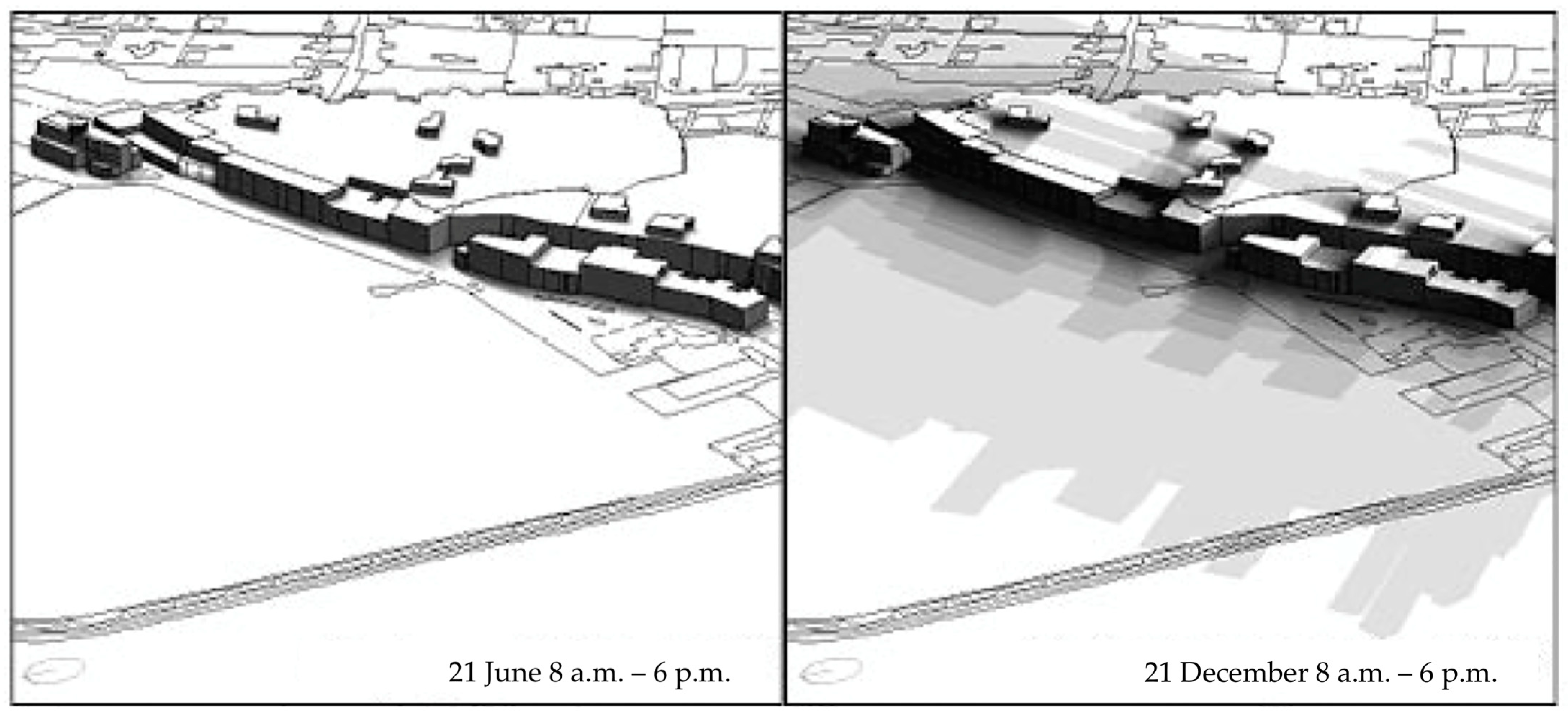


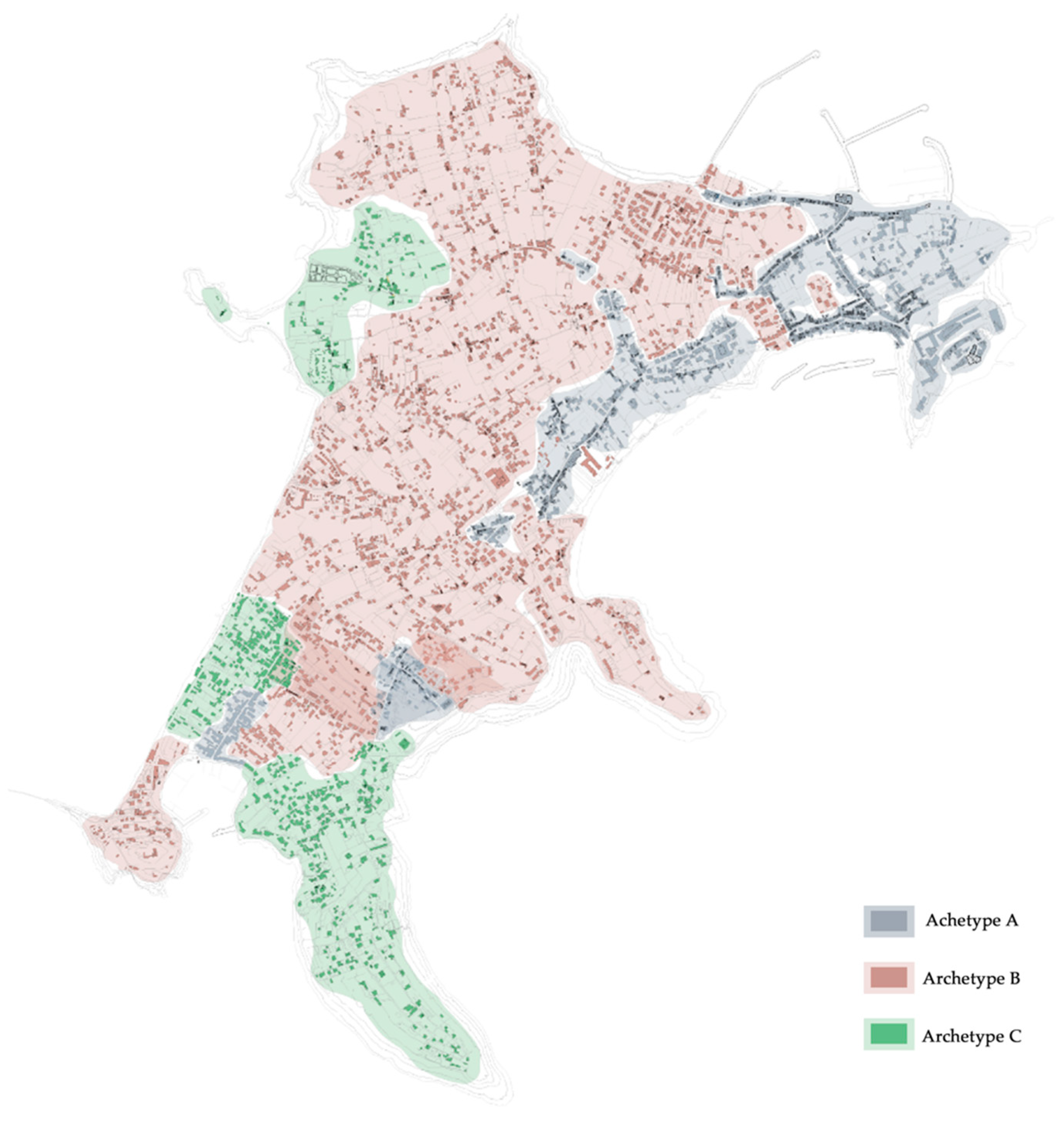

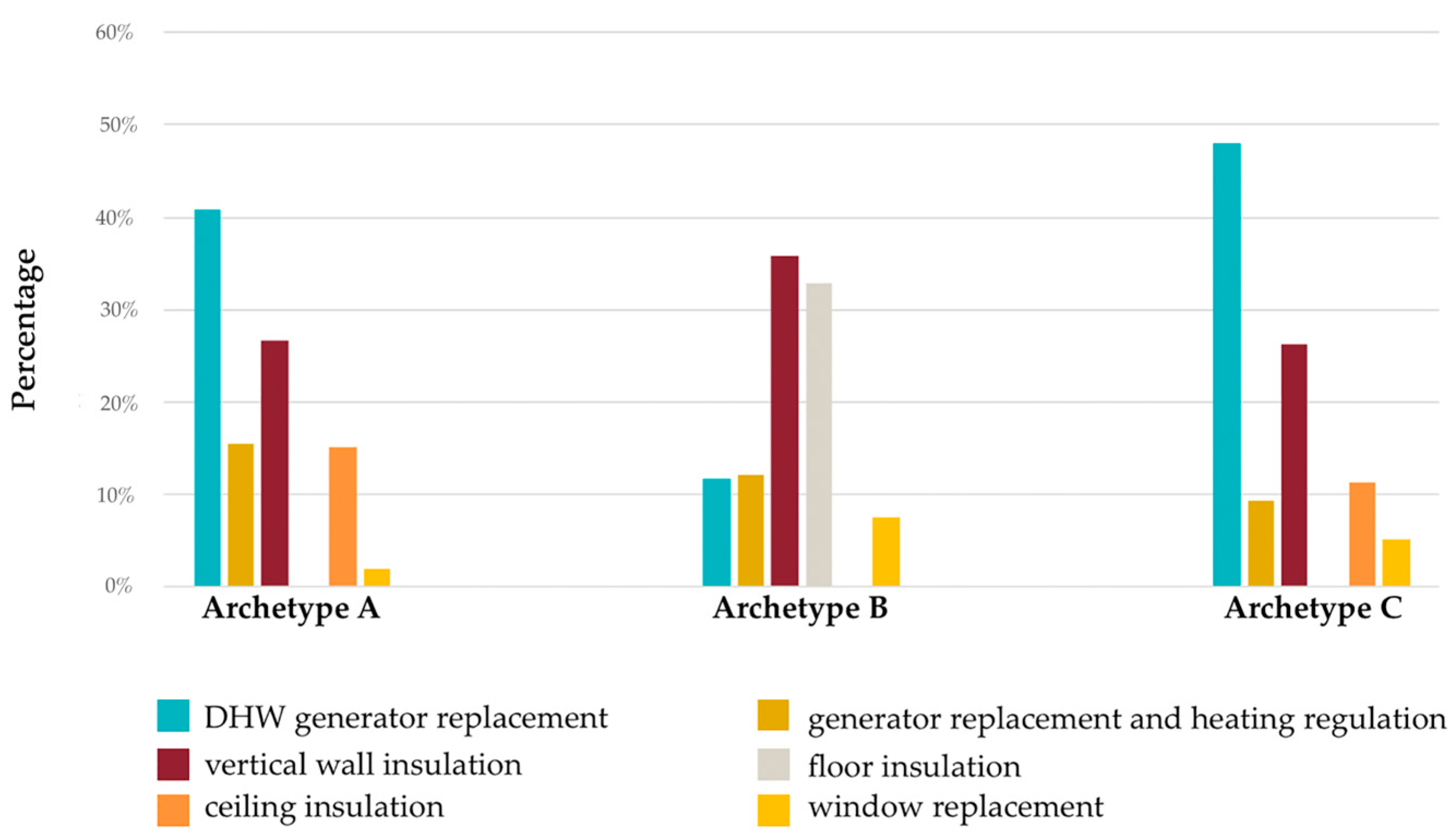

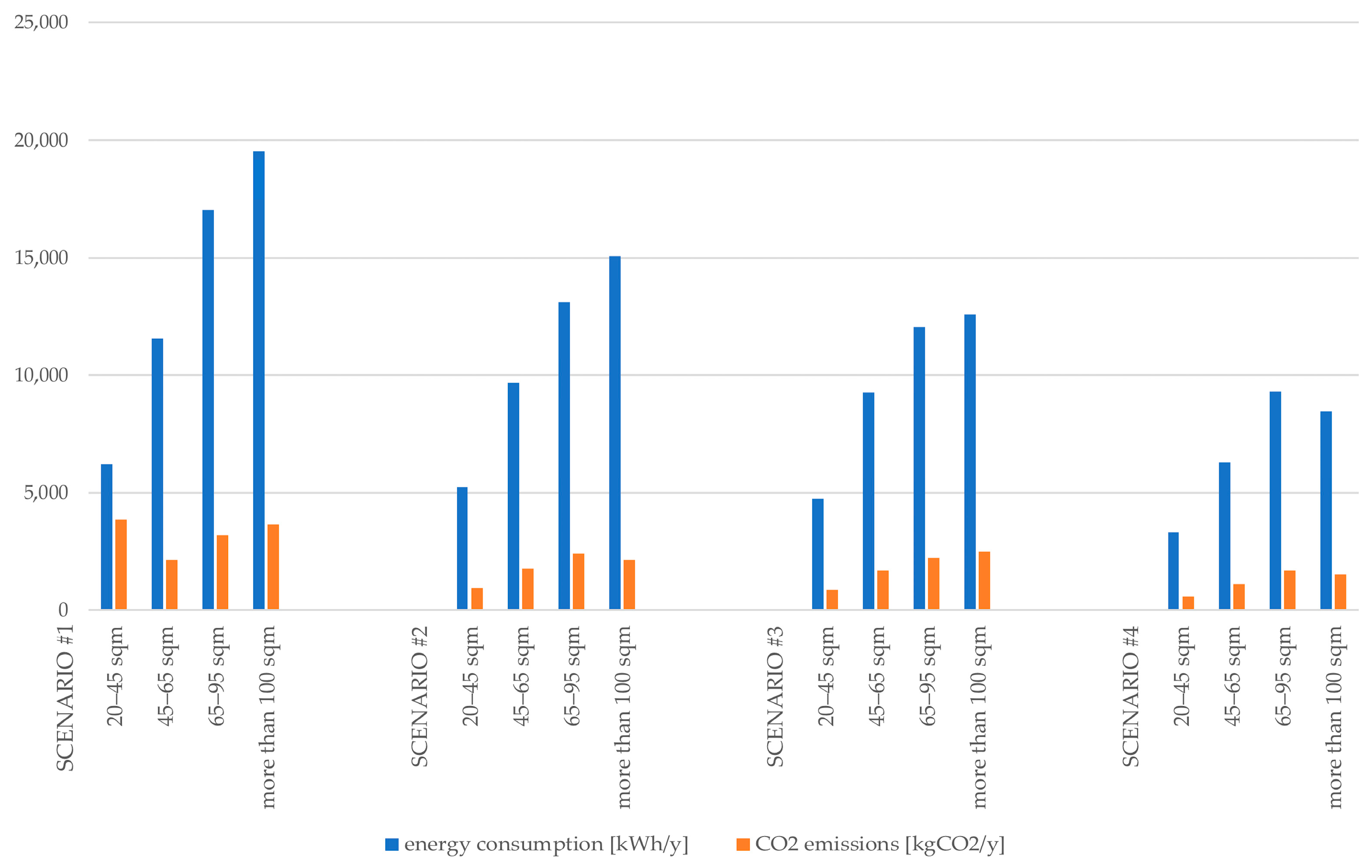
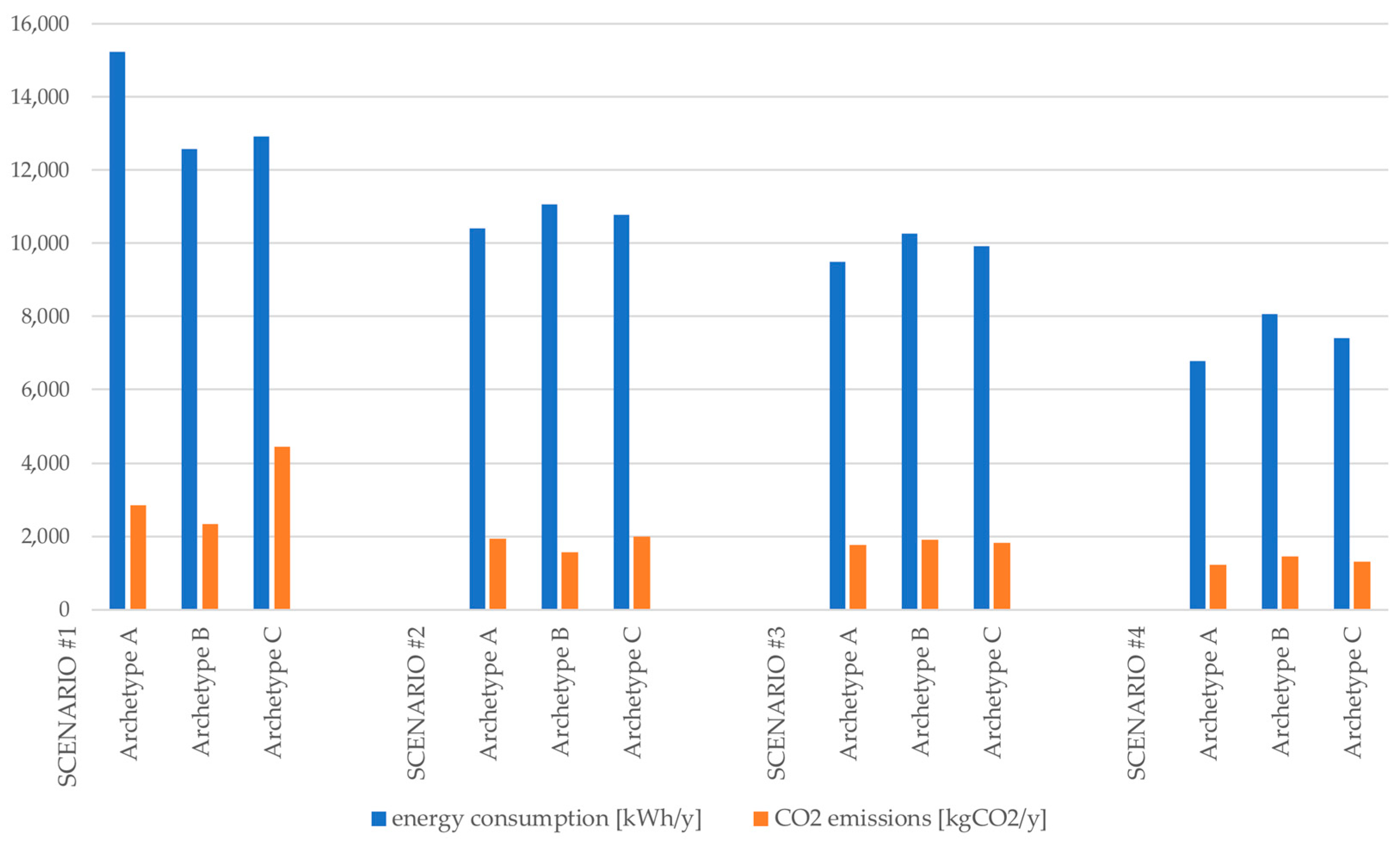
Disclaimer/Publisher’s Note: The statements, opinions and data contained in all publications are solely those of the individual author(s) and contributor(s) and not of MDPI and/or the editor(s). MDPI and/or the editor(s) disclaim responsibility for any injury to people or property resulting from any ideas, methods, instructions or products referred to in the content. |
© 2024 by the authors. Licensee MDPI, Basel, Switzerland. This article is an open access article distributed under the terms and conditions of the Creative Commons Attribution (CC BY) license (https://creativecommons.org/licenses/by/4.0/).
Share and Cite
Romano, G.; Baiani, S.; Mancini, F. Integrating Technological Environmental Design and Energy Interventions in the Residential Building Stock: The Pilot Case of the Small Island Procida. Sustainability 2024, 16, 8071. https://doi.org/10.3390/su16188071
Romano G, Baiani S, Mancini F. Integrating Technological Environmental Design and Energy Interventions in the Residential Building Stock: The Pilot Case of the Small Island Procida. Sustainability. 2024; 16(18):8071. https://doi.org/10.3390/su16188071
Chicago/Turabian StyleRomano, Giada, Serena Baiani, and Francesco Mancini. 2024. "Integrating Technological Environmental Design and Energy Interventions in the Residential Building Stock: The Pilot Case of the Small Island Procida" Sustainability 16, no. 18: 8071. https://doi.org/10.3390/su16188071







